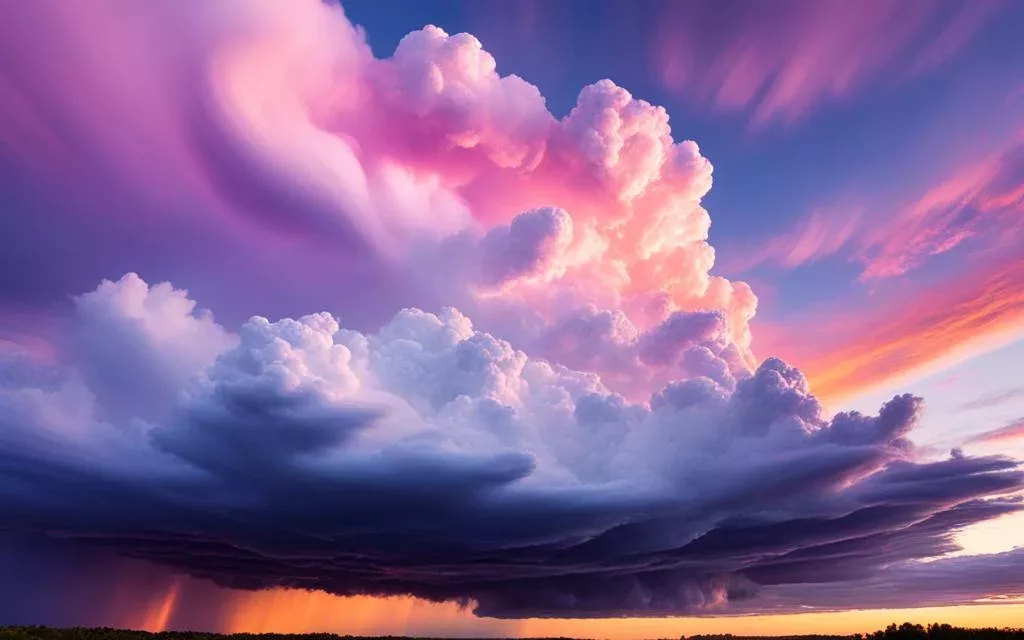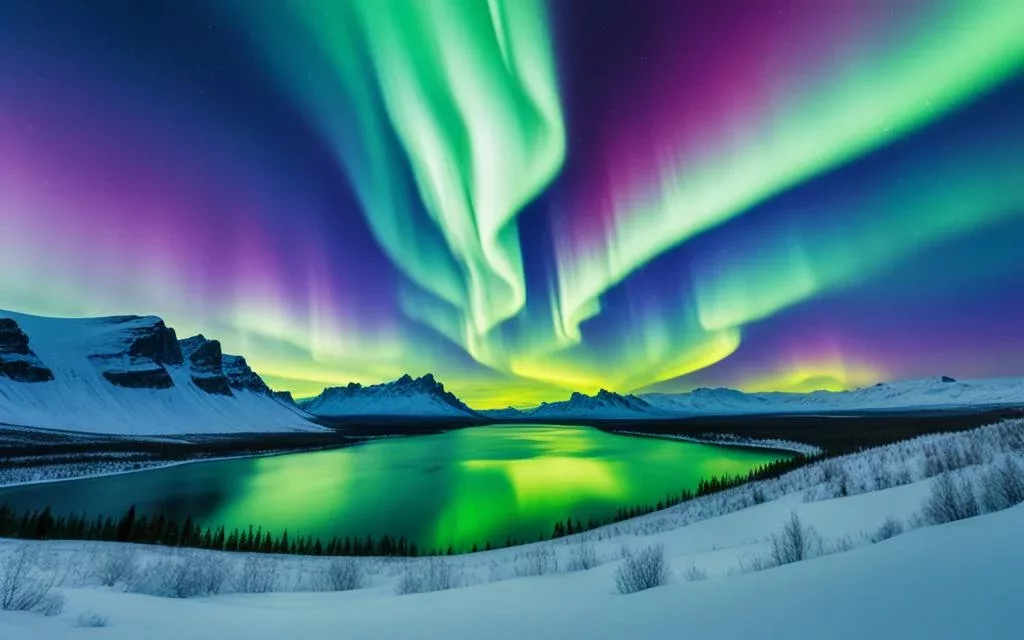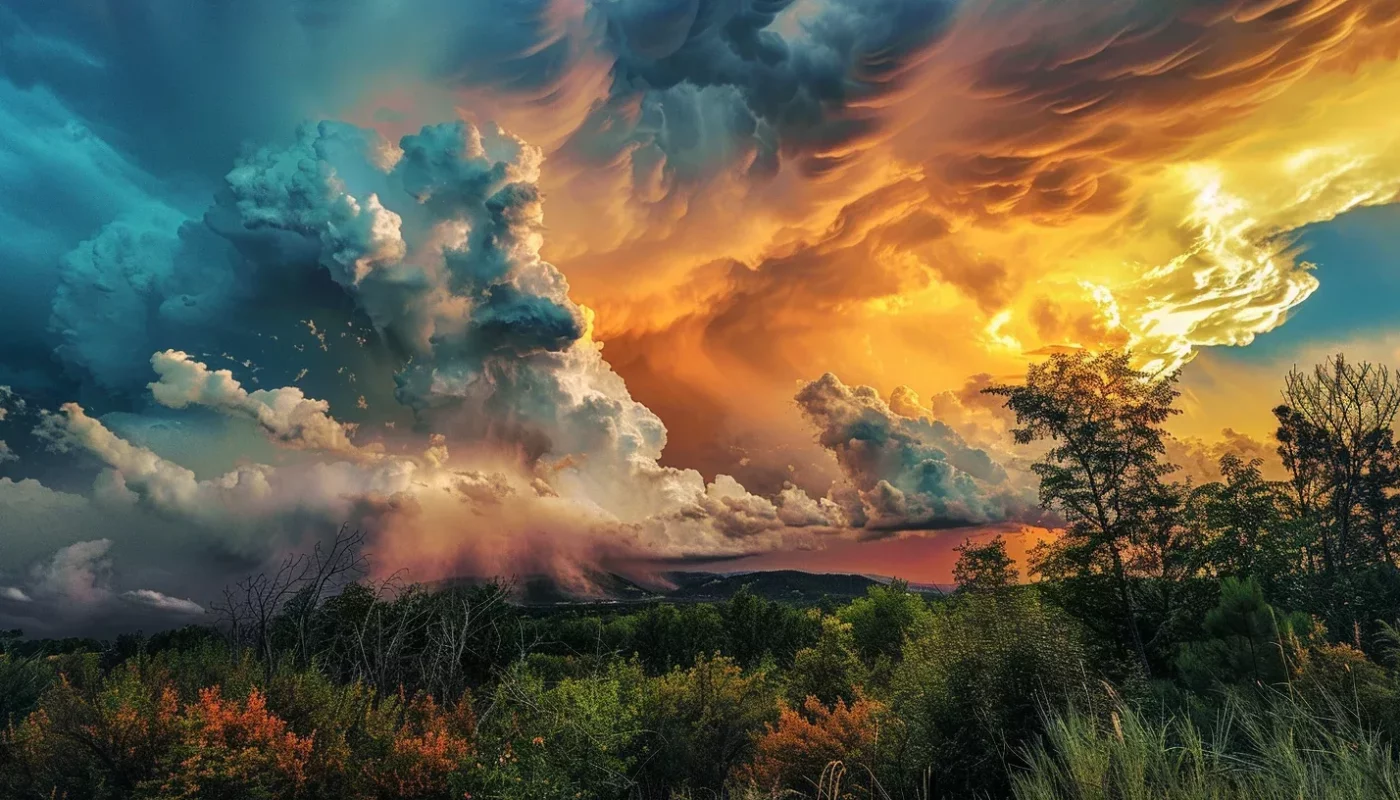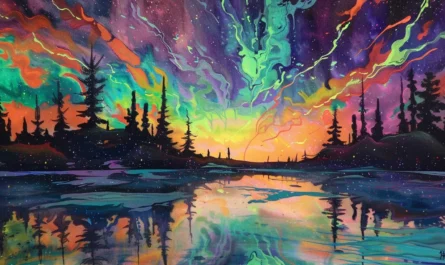Did you know our skies host rare weather phenomena that amaze us? From the striking auroras at the poles to vibrant lightning storms, nature’s shows are breathtaking. The science of atmospheric optics explains how sunlight and atmosphere create these wonders.
These events inspire us and help predict weather and study climate. Let’s dive into the world of atmospheric optics. We’ll discover the science behind stunning sunsets, vivid rainbows, and more.
Conserving these phenomena matters for future generations. Understanding our environmental impact is key. By acting to protect our planet, we keep these wonders alive. Let’s embrace the beauty of atmospheric optics and nature’s spectacles together.
Unraveling the Basics of Atmospheric Optics
Atmospheric optics is about studying how sunlight interacts with the Earth’s atmosphere. This creates amazing sights like mirages, the blue sky, and rainbows. Mirages happen when light bends passing through different air temperatures. Rayleigh scattering explains why the sky is blue. It also causes stunning sunrises and sunsets. Rainbows appear when sunlight scatters through raindrops. Also, we see halos caused by ice crystals in the sky.
Mirages are optical illusions from light bending in layers of air. This bending makes things look distorted or out of place. They are common in deserts, where ground heat affects air temperatures sharply.
Rayleigh scattering makes the sky blue during the day. Sunlight hits air molecules, scattering blue and violet light more than red and orange. This gives the sky its color when looking up.
Sunrise and sunset colors come from the same light scattering. When the sun is low, light travels through more air, which scatters short wavelengths. This creates vibrant reds, oranges, pinks, and purples in the sky.
Rainbows form when sunlight goes through raindrops. Each drop breaks sunlight into colors, like a prism. The light reflects inside the drop and comes out as an arc of colors.
Atmospheric optics also brings us halos around the sun or moon. These are from light bending and scattering off ice crystals high in the sky. The crystals’ shape makes the halo, and sometimes we see bright spots called sun dogs too.
Learning about atmospheric optics helps us understand beautiful sky events. It shows the cool ways sunlight and air work together. Appreciating these helps us see the beauty and complexity of our natural world.
How Atmospheric Optics Influence Natural Phenomena
Atmospheric optics is a field that helps us understand the beauty in our skies. It explains the colors of sunsets, rainbows, and even mirages. This science makes natural spectacles even more fascinating.
Sunsets are striking thanks to atmospheric optics. Sunlight interacts with the air and water droplets. This creates vibrant skies we love to watch.
“Sunsets are a testament to the intricate dance between light and atmospheric optics.”
Rainbows form through a similar process. Sunlight refracts and reflects off water in the air. This gives us the colorful spectrum we see in the sky.
Halos appear due to ice crystals high in the clouds refracting light. These rings around the sun or moon delight those who gaze up.
Mirages are fascinating illusions caused by how light bends in different temperatures. For example, a mirage can make it look like there’s water on a hot road. This shows light’s amazing effects on our environment.
Learning about atmospheric optics helps us enjoy natural wonders even more. It teaches us the science behind beautiful skies. By exploring this field, we uncover the secrets of the atmosphere. This deepens our appreciation for nature’s beauty.
| Atmospheric Phenomenon | Description |
|---|---|
| Rainbows | The dispersion of light by water droplets in the air creates a spectacular spectrum of colors. |
| Halos | The refraction of light by ice crystals in high-altitude clouds forms beautiful circles of light around the sun or moon. |
| Mirages | Bending of light due to temperature gradients in the atmosphere creates intriguing visual illusions. |
Conservation of Atmospheric Optics
It’s crucial to protect the beauty of atmospheric optics. Climate change and human actions can affect these natural events. By being aware and living sustainably, we can help preserve these phenomena for the future.
Understanding atmospheric optics connects us with the natural world. It inspires awe and wonder. As we continue to explore and appreciate, we enjoy the splendid sights above us more deeply.
The Science of Sky Coloration
The blue sky we love is thanks to Rayleigh scattering. This happens when sunlight’s shorter wavelengths, like blue, get scattered more by the atmosphere’s molecules. Hence, our sky looks blue. Atmospheric particles absorb and reradiate light in various directions. More particles mean more scattering, deepening the blue of the sky.
At dawn and dusk, the sky wows us with its colors. The stunning reds, oranges, and purples come from the particles in the air. With the sun low, its light crosses more atmosphere, scattering short-wavelength colors. This gives us the beautiful red and orange sunset colors.
The sky’s beauty is also impacted by how many particles are in the air. On clear days, with fewer particles, the sky’s blue is vibrant. But more particles, from pollution or volcanic ash, can make the sky hazy or change its color. These changes offer us unique sights, showing the ever-changing nature of our surroundings.
Knowing about sky coloration deepens our love for nature and teaches us about the atmosphere. It shows us how sunlight and particles mix to paint the sky. By understanding this, we learn about Earth’s balance and how to protect it.
The Enchanting World of Cloud Coloration
Clouds change constantly above us, catching our eyes with their beauty. They come in many colors, thanks to sunlight and their makeup of water or ice. These colors create breathtaking scenes in the sky. Let’s explore how cloud colors make our skies lively and beautiful.

Many things affect cloud color, like how light scatters and what’s in the atmosphere. When sunlight goes through clouds, it spreads out because of water droplets or ice. This spread of light gives the sky its vivid colors.
The type and size of cloud particles matter a lot for color. Thin, high clouds with ice can make stunning rings around the sun or moon. The light bends and spreads out, forming bright circles in the sky.
Clouds look different because of things like smog, soot, or natural specks in the air. These particles change how light travels, altering cloud colors. Water droplets or ice mixing with these particles create a wide range of sky colors.
Studying cloud colors helps us understand the atmosphere better. By looking at cloud patterns and colors, scientists learn about weather and climate changes. This knowledge is key for predicting weather and studying our climate.
Cloud Coloration and Conservation
“To see the world in a grain of sand, and to see heaven in a wildflower, hold infinity in the palm of your hands, and eternity in an hour.” – William Blake
Admiring cloud colors is important, but we must also think about protecting them. Clouds and weather events are part of nature’s beauty. Yet, climate change and human actions threaten them.
To keep this beauty for future generations, we need to take action. By caring about our atmosphere and lessening harm, we help preserve these amazing views.
Factors Influencing Cloud Coloration
| Factors | Description |
|---|---|
| Scattering | The interaction between sunlight and particles in the clouds, causing light to disperse and create different colors. |
| Reflection | The bouncing of light off cloud particles, altering its path and contributing to the overall coloration. |
| Ice Crystals | The presence of ice crystals within the clouds, leading to the formation of halos and other optical phenomena. |
| Particulate Matter | The inclusion of smog, soot, or natural aerosols in the clouds, modifying their colors through absorption and scattering of light. |
Unveiling the Secrets of Mirages
Mirages are fascinating optical phenomena that capture our imagination. They happen because of temperature differences in the atmosphere. This causes light to bend as it moves through air layers at different temperatures, leading to visual illusions.
One well-known example is the mirage of water on a hot road. Here, light bending makes it look like there’s a water pool ahead.
Mirages can show up in many forms, each creating unique visual effects. The Novaya Zemlya effect is one, where the Sun seems to hover above the horizon even when it’s below it. This creates a mirage of a double Sun. The Fata Morgana is another spectacular mirage, creating complex, distorted views of objects on the horizon.
The science behind mirages reveals how light and our environment interact. Light changes direction when it hits areas with different temperature densities. This makes things appear in places they aren’t or seem twisted. These changes in light create the wonderful illusions known as mirages.
By understanding mirages, we learn more about nature and the science of light. Mirages remind us that what we see isn’t always real. They show how the environment can alter our perceptions.
The Magic of Rainbows
Rainbows are fascinating natural wonders caused by sunlight scattering off water droplets. Each raindrop works as a mini prism, splitting light at different angles. This process separates light into a spectrum of colors, creating the rainbow we see.
Raindrops are spherical, which makes light act predictably. When sunlight enters a raindrop, it bends and bounces inside. This bending and bouncing, known as refraction and reflection, create the rainbow.
When the sun is low, it lights up more raindrops over the horizon. This makes a larger rainbow arc visible. Rainbows need many raindrops to form. We usually see just an arc of the full circle. But from high up, like in an airplane, the complete circle can sometimes be seen.
Rainbows form as circular arcs opposite the sun because of how light interacts with raindrops. Light enters a drop, bends, bounces inside, then exits and bends again. This mix of bending and bouncing spreads the light into colors, making the rainbow.
Everyone sees a different rainbow because of where they stand in relation to the sun and raindrops. The light touches our eyes in unique ways, creating a personal rainbow for each of us. This makes witnessing a rainbow a special and awe-inspiring experience.
The Color Spectrum of Rainbows
A rainbow displays colors in a specific order from red to violet. The way light disperses inside raindrops decides each color’s position and brightness. This depends on the angle at which light enters and exits the raindrops.
| Color | Angle of Dispersion (degrees) |
|---|---|
| Red | 42 |
| Orange | 41 |
| Yellow | 40 |
| Green | 39 |
| Blue | 38 |
| Indigo | 37 |
| Violet | 36 |
The angle of dispersion changes slightly for each color, with red around 42 degrees and violet near 40 degrees. These differences in angles make the colors of the rainbow stand apart.
“Rainbows are nature’s incredible display of light and color. They remind us of the beauty and diversity present in the world around us. Each sighting of a rainbow is a unique experience, as no two rainbows are ever exactly the same. It is a magical moment that fills our hearts with wonder and joy.”
In the end, rainbows show how light, water droplets, and optical phenomena mix in the air. They capture our imagination with their bright colors and mysterious presence. Rainbows are more than just beautiful; they highlight the science in our natural world.
Continue reading about the science behind rainbows here.
Halos: Rings of Light in the Sky
Halos are fascinating rings of light seen around the sun or moon. These rings happen when sunlight or moonlight bends through ice crystals in the clouds. The way light interacts with ice creates various shapes and sizes of halos, amazing everyone who sees them.
What shapes these halos are the ice crystals’ properties. Depending on whether they’re hexagonal or like plates, different halos can form. These ice particles scatter light, making beautiful rings in the sky.
Sometimes, you might see sun dogs near the sun within these halos. They are bright lights caused when sunlight bends through hexagonal ice crystals. This bending of light makes extra bright spots appear.
The beauty of halos lies in their ability to transform a seemingly ordinary sky into a canvas of enchantment, reminding us of the mysteries and wonders that unfold above us.
Types of Halos
| Halo Type | Description |
|---|---|
| Circular Halo | A ring of light with a 22-degree radius around the sun or moon. |
| Supralateral Arc | A bright arc extending from both sides of the halo, passing through the sun or moon. |
| 22-Degree Halo | A circular halo with a radius of approximately 22 degrees around the sun or moon. |
| Parhelic Circle | A halo that runs parallel to the horizon, intersecting the zenith. |
| Upper Tangent Arc | An arc tangent to the top of the halo. |
| Lower Tangent Arc | An arc tangent to the bottom of the halo. |
Seeing a halo is an unforgettable moment. It shows the beautiful interaction between sun light and ice above our planet.
Phenomenal Twilight: Colors of Dusk and Dawn
Dusk and dawn are truly magical times. They fill the sky with a stunning blend of colors. The amazing colors we see at twilight happen because of how sunlight interacts with air.
As the sun sets or rises, its light goes through a lot of air. This makes blues and violets scatter away. This action, called Rayleigh scattering, brings out the lovely oranges, pinks, and purples we see.
This scattering of light by air shows us a breathtaking scene. Light bounces off things like dust and pollen. This creates the beautiful twilight colors that win our hearts.
“Twilight’s changing colors come from sunlight scattering off air particles. With the sun low in the sky, it hits more air. This makes shorter colors like blue scatter more, leaving vibrant oranges, pinks, and purples behind.”
The twilight colors are not just pretty. They’re also important for science. By looking at twilight, scientists learn about air particles and sunlight’s effects on earth.
When you see the stunning colors of dusk or dawn, think about the sun and air working together. Twilight shows us the beauty and complexity of nature. It’s a daily magic show above us.
Conservation of Twilight Beauty
The beauty of twilight reminds us to care for our planet. Environmental damage and climate change can alter twilight’s colors. By helping the environment and reducing our carbon footprint, we keep twilight’s magic alive for the future.
Chasing Lightning: Nature’s Electric Display
Lightning is both fascinating and powerful. It happens when there’s an electrical discharge in the sky. This can be between clouds or from a cloud to the ground. Thunderstorms bring it to life, moving electrical currents within.
There are different types of lightning, each unique. The most known type is cloud-to-ground. In this case, electricity travels from a cloud to earth. There’s also cloud-to-air and intra-cloud lightning, adding to its wonder.
Studying lightning tells us a lot about our atmosphere. It helps scientists predict weather and keep us safe. They use this data to forecast storms and protect our buildings.
Lightning Facts
- Lightning is a rapid and intense atmospheric discharge of electrical energy.
- It is estimated that about 100 lightning bolts strike the Earth’s surface every second.
- Lightning can reach temperatures of up to 30,000 Kelvin, hotter than the surface of the sun.
- The average length of a lightning bolt is approximately 2 to 3 miles, but it can extend up to 10 miles or more.
- Thunder is the sound produced by the rapid expansion and contraction of air molecules due to the intense heat generated by lightning.
Lightning is not only a striking natural phenomenon but also a reminder of the immense power and complexity of our atmosphere. Studying lightning provides us with valuable insights into the dynamic processes that shape our weather systems and helps us improve our understanding of the natural world.
| Type of Lightning | Description |
|---|---|
| Cloud-to-Ground | Electric discharge between the cloud and the Earth’s surface. |
| Cloud-to-Air | Lightning confined within a cloud, without directly interacting with the ground. |
| Intra-Cloud | Lightning that occurs between different parts of a cloud, creating spectacular displays of light. |
Conservation of Rare Weather Phenomena
We all love to see rare weather wonders. It’s key to think about how to keep them safe and consider environmental effects. Climate change and our actions can change how often they happen. This shows why we must work to keep their beauty and importance.
Conservation is crucial for keeping these rare weather events for future generations. By learning about these events, we can spread knowledge and support eco-friendly habits.
Climate change is a big hurdle for saving these rare weather events. Changes in the weather can upset the balance needed for these sights to occur. We need to tackle climate change factors, like cutting down on pollution and using green energy.
Our actions can harm rare weather events too. Things like pollution, cutting down forests, and destroying habitats can harm the environments that support these sights. It’s important to take steps to keep natural areas safe and maintain the conditions these events need.
“Rare weather events show us the stunning beauty and power of nature. Saving them means we protect their visual wonder and help keep the balance of our ecosystem.”
Groups and people are working hard to save these rare weather sights. They focus on fixing habitats, teaching others, and pushing for eco-friendly choices to lessen our impact on the environment.
By helping with these efforts and living greener, we can help save these amazing weather events. If we work together, we can make sure the next generations can also enjoy the beautiful auroras, exciting lightning, and other amazing sights in our skies.

| Conservation Strategies | Benefits |
|---|---|
| 1. Protecting natural habitats | – Preserves the ecosystems that support rare weather phenomena. |
| 2. Promoting sustainable practices | – Reduces the environmental impact of human activities on these spectacles. |
| 3. Education and awareness programs | – Increases public understanding and appreciation of rare weather phenomena. |
| 4. Advocacy for climate action | – Addresses the root causes of climate change that affect these atmospheric spectacles. |
Conclusion
The study of atmospheric optics reveals how Nature’s Atmospheric Spectacles shine. Light and air particles mix to show us sunsets and rainbows. We also see halos, mirages, and lightning‘s strength. This knowledge lets us appreciate the natural events even more.
These wonders make us think about protecting them from climate change and human harm. Understanding Nature’s Atmospheric Spectacles can motivate us. It helps us push for actions that preserve these marvels for the future.
We should love and keep learning about atmospheric optics. The beauty of light and air above us is truly awe-inspiring. The incredible sights of Nature’s Atmospheric Spectacles remind us of the world’s beauty.




